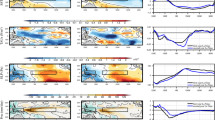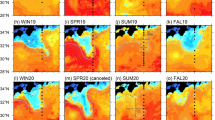Abstract
Satellite images of sea surface temperature (SST) show that the location of cross-shore SST minimum (LCSM) stretches along the isobaths in the Northwest Africa Upwelling System. To understand and interpret these observations better, we set up a two-dimensional analytical model that takes into account the surface and bottom Ekman transport and the alongshore geostrophic current, as well as bottom friction and variations in bottom topography. The structure of vertical velocity with a realistic topography clearly illustrates the variations of SST drop in a sample cross-shore section. Some idealized theoretical model experiments are carried out to examine the effects of eddy viscosity, Coriolis force, and cross-shore wind on the location of the cross-shore maximum upwelling intensity. The results show that the cross-shore wind largely impacts on the location where the coldest water outcrops to the surface through an adjustment of the cross-shore pressure gradient. This is also verified by the remotely sensed data, which indicate that the maximum correlation coefficient between cross-shore wind stress and the depth of LCSM is −0.65 with a lag of approximately 1 day.







Similar content being viewed by others
References
Arístegui J, Barton ED, Álvarez-Salgado XA, Santos AMP, Figueiras FG, Kifani S, Hernández-León S, Mason E, Machú E (2009) Sub-regional ecosystem variability in the Canary Current upwelling. Prog Oceanogr 83:33–48
Brink KH (1983) Low-frequency free wave and wind-driven motions over a submarine bank. J Phys Oceanogr 13:103–116
Estrade P, Marchesiello P, Verdière ACD, Roy C (2008) Cross-shelf structure of coastal upwelling: a two-dimensional extension of Ekman’s theory and a mechanism for inner shelf upwelling shut down. J Mar Res 66:589–616
Jiang L, Breaker LC, Yan XH (2010) A model for estimating cross-shore surface transport with application to the New Jersey Shelf. J Geophys Res 115:C04017. doi:10.1029/2009JC005998
Johnson J, Stevens L (2000) A fine resolution model of the eastern North Atlantic between the Azores, the Canary Islands and the Gibraltar Strait. Deep Sea Res I 47:875–899
Kamenkovich VM (1977) Fundamentals of ocean dynamics (trans: Radok R). Elsevier Scientific, New York, pp 127–134
Lentz SJ (1995) Sensitivity of the inner-shelf circulation to the form of the eddy viscosity profile. J Phys Oceanogr 25:19–28
Marcello J, Hernández-Guerra A, Eugenio F, Fonte A (2011) Seasonal and temporal study of the northwest African upwelling system. Int J Remote Sens 32:1843–1859
Mitchum GT, Clarke AJ (1986) The frictional nearshore response to forcing by synoptic scale winds. J Phys Oceanogr 16:934–946
Roy C (1998) An upwelling-induced retention area off Senegal: a mechanism to link upwelling and retention processes. S Afr J Mar Sci 19:89–98
Ryan JP, Yoder JA, Townsend DW (2001) Influence of a Gulf Stream warm-core ring on water mass and chlorophyll distributions along the southern bank of Georges Bank. Deep Sea Res II 48:159–178
Santos AMP, Kazmin AS, Peliz A (2005) Decadal changes in the Canary upwelling system as revealed by satellite observations: their impact on productivity. J Mar Res 63:359–379
Souza AJ, Alvarez LG, Dickey TD (2004) Tidally induced turbulence and suspended sediment. Geophys Res Lett 31:L20309. doi:10.1029/2004GL021186
Welander P (1957) Wind action in a shallow sea: some generalizations of Ekman’s theory. Tellus 9:45–52
Wooster WS, Bakum A, McLain DR (1976) The seasonal upwelling cycle along the eastern boundary of the North Atlantic. J Mar Res 34:131–141
Acknowledgments
This study was originally inspired by the work of Estrade et al. (2008). This research was supported by the Natural Science Foundation of China (grant no. 41076001) and the Fundamental Research Funds for the Central Universities (grant no. 2010121029) of China. We also thank Federico Ienna for editorial assistance with our English, and the two anonymous reviewers for helpful comments on the manuscript.
Author information
Authors and Affiliations
Corresponding author
Appendix: Derivation of the horizontal velocity
Appendix: Derivation of the horizontal velocity
Welander (1957) extended the Ekman theory to varying bathymetry. Kamenkovich (1977) added a geostrophic component into the equation associated with the pressure gradient term. Estrade et al. (2008) finally obtained the geostrophic velocity and solved the exact solution using the assumption that cross-shore Ekman transport equals zero. Jiang et al. (2010) used a one-dimensional numerical model to solve the momentum equation. Following their work, in a steady, unstratified, and homogeneous ocean, we assume a constant density ρ = 1025 kg m−3 and vertical eddy viscosity A z , and ignore the horizontal advection terms. The momentum equation is
where P is the pressure, f is the Coriolis parameter, and \( \vec{k} \) is a vertical unit vector. The solution of the equation can be obtained by separating the horizontal velocity components into an Ekman part and a geostrophic part \( \vec{V} = \vec{u}_{\text{e}} + \vec{u}_{\text{g}} , \) and by introducing the complex variables \( \vec{u}_{\text{e}} = u_{\text{e}} + iv_{\text{e}} \), \( \vec{u}_{\text{g}} = u_{\text{g}} + iv_{\text{g}}, \) and wind stress \( \vec{\tau } = \tau_{x} + i\tau_{y} \). Equation (2) can thus be written as
Here, we take a right-handed coordinate system, in which x is in cross-shore direction, positive eastward; positive y is 90° counterclockwise from the positive x-direction; and z is the vertical direction, positive upward. The surface and bottom boundary conditions are
The solution of Eq. (3) with boundary condition (4) is
in which \( j = (1 + i)\sqrt {f/2A_{z} } . \) The depth-integrated transport from z = −h to the surface is
As Brink (1983) and Mitchum and Clarke (1986) did in their previous studies, we introduce Ekman layer structure functions which simplify the form of the solutions and therefore allow for an intuitive explanation of the results. These functions are defined as
where \( D = \sqrt {2A_{z} /f} \) is the Ekman depth. Assuming that wind forcing is uniform and alongshore variation of terrain is small, the ∂P/∂y term becomes negligible so that the cross-shore geostrophic velocity u g is zero. We then have the cross-shore Ekman transport
The no-flow penetration condition at the shore requires that the cross-shore transport M x is equal to zero at the coast and must be equal to zero in the entire water column. The geostrophic velocity becomes
Substituting expression (9) into Eq. (5), we obtain the horizontal velocity \( \vec{V} \) as
Rights and permissions
About this article
Cite this article
Chen, Z., Yan, XH., Jiang, Y. et al. A study of cross-shore maximum upwelling intensity along the Northwest Africa coast. J Oceanogr 69, 443–450 (2013). https://doi.org/10.1007/s10872-013-0185-5
Received:
Revised:
Accepted:
Published:
Issue Date:
DOI: https://doi.org/10.1007/s10872-013-0185-5




